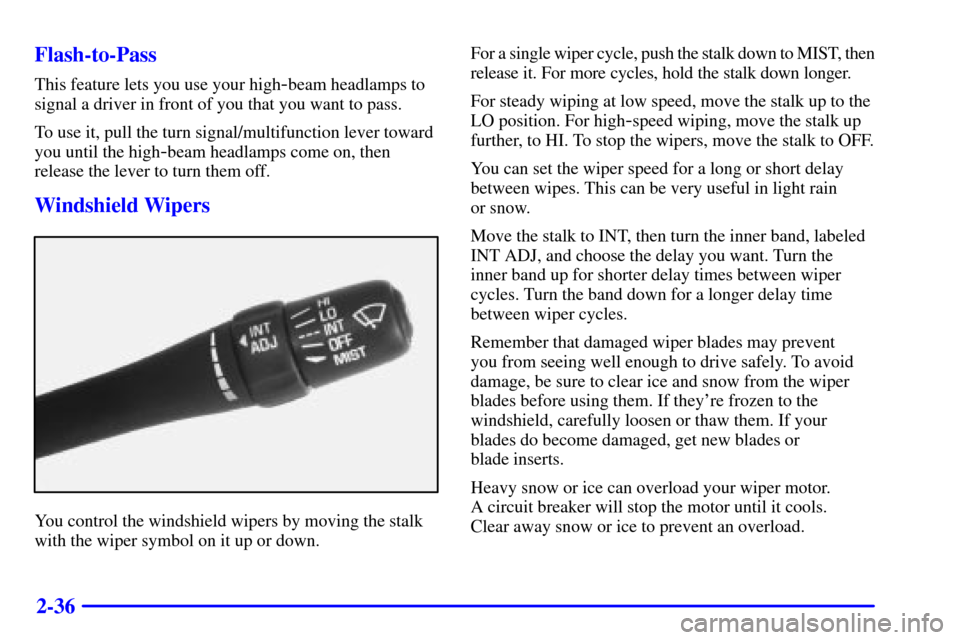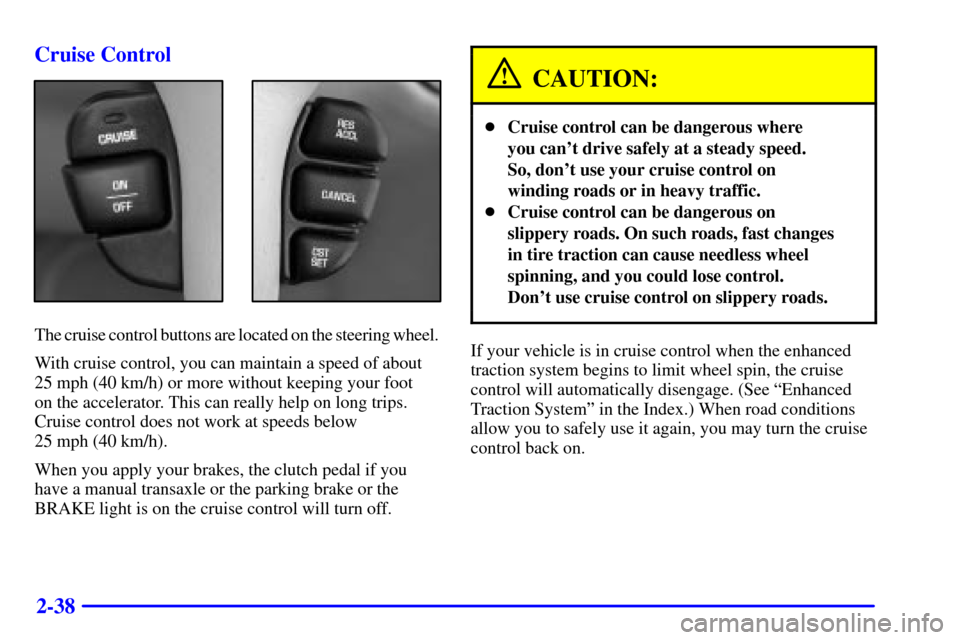Page 66 of 327

2-
2-1
Section 2 Features and Controls
Here you can learn about the many standard and optional features on your vehicle, and information on starting,
shifting and braking. Also explained are the instrument panel and the warning systems that tell you if everything is
working properly
-- and what to do if you have a problem.
2
- 2 Keys
2
- 4 Door Locks
2
- 9 Remote Lock Control (If Equipped)
2
- 13 Trunk
2
- 15 Theft
2
- 16 Passlock�
2- 16 New Vehicle ªBreak-Inº
2
- 17 Ignition Switch
2
- 18 Starting Your Engine
2
- 20 Engine Coolant Heater (If Equipped)
2
- 22 Automatic Transaxle Operation
2
- 25 Manual Transaxle Operation
2
- 27 Parking Brake
2
- 28 Shifting Into PARK (P)
(Automatic Transaxle Only)
2
- 30 Shifting Out of PARK (P)
(Automatic Transaxle Only)
2
- 30 Parking Your Vehicle
(Manual Transaxle Models Only)2
- 31 Parking Over Things That Burn
2
- 31 Engine Exhaust
2
- 32 Running Your Engine While You're Parked
(Automatic Transaxle)
2
- 33 Windows
2
- 34 Tilt Wheel
2
- 34 Turn Signal/Multifunction Lever
2
- 41 Exterior Lamps
2
- 44 Interior Lamps
2
- 46 Mirrors
2
- 47 Storage Compartments
2
- 48 Ashtray and Lighter (If Equipped)
2
- 48 Sun Visors
2
- 49 Auxiliary Power Accessory Outlet
2
- 49 Sunroof (If Equipped)
2
- 50 Instrument Panel - Your Information System
2
- 54 Warning Lights, Gages and Indicators
Page 80 of 327

2-15
Theft
Vehicle theft is big business, especially in some cities.
Although your vehicle has a number of theft
-deterrent
features, we know that nothing we put on it can make
it impossible to steal. However, there are ways you
can help.
Key in the Ignition
If you leave your vehicle with the keys inside, it's an
easy target for joy riders or professional thieves
-- so
don't do it.
When you park your vehicle and open the driver's door,
you'll hear a chime reminding you to remove your key
from the ignition and take it with you. Always do this.
Your ignition and transaxle will be locked. And
remember to lock the doors.
Parking at Night
Park in a lighted spot, close all windows and lock your
vehicle. Remember to keep your valuables out of sight.
Put them in a storage area, or take them with you.
Parking Lots
If you park in a lot where someone will be watching
your vehicle, it's best to lock it up and take your keys.
But what if you have to leave your key?
�If possible, park in a busy, well lit area.
�Put your valuables in a storage area, like your
trunk or glove box. Be sure to close and lock the
storage area.
�Close all windows.
�Move the trunk release lockout switch to the
ON position.
�Lock the glove box.
�Lock all the doors except the driver's.
�If your vehicle has a remote lock control system,
take the transmitter with you.
Page 81 of 327

2-16
Passlock�
Your vehicle is equipped with the Passlock
theft
-deterrent system.
Passlock is a passive theft
-deterrent system. Passlock
enables fuel if the ignition lock cylinder has not been
tampered with.
During normal operation, the SECURITY light will go
off approximately five seconds after the ignition key is
turned to ON and the engine is started.
If the SECURITY light flashes with the key to ON,
wait 10 minutes until the light goes off. Then turn the
ignition to OFF before attempting to start the engine.
In an emergency, call the Oldsmobile Roadside
Assistance Center at 1
-800-442-OLDS or
1
-800-442-6537. (In Canada, call 1-800-268-6800.)
New Vehicle ªBreak-Inº
NOTICE:
Your vehicle doesn't need an elaborate
ªbreak
-in.º But it will perform better in the
long run if you follow these guidelines:
�Don't drive at any one speed -- fast or
slow
-- for the first 500 miles (805 km).
Don't make full
-throttle starts.
�Avoid making hard stops for the first
200 miles (322 km) or so. During this time
your new brake linings aren't yet broken
in. Hard stops with new linings can mean
premature wear and earlier replacement.
Follow this breaking
-in guideline every
time you get new brake linings.
�Don't tow a trailer during break
-in.
See ªTowing a Trailerº in the Index for
more information.
Page 82 of 327

2-17
Ignition Switch
With the ignition key in the ignition switch, you can turn
the switch to four positions.
OFF (A): Before you put the key into the ignition switch,
the switch is off. It is the only position from which you can
remove the key. With an automatic transaxle, the shift lever
must be to PARK (P) with the ignition to OFF to remove
the key. With a manual transaxle, the shift lever must be to
REVERSE (R) with the ignition to OFF to remove the key.
This position locks your ignition and transaxle. A warning
chime will sound if you open the driver's door when the
ignition is off and the key is in the ignition.ACC (Accessory) (B): This position unlocks the
transaxle. It also lets you use things like the radio and
windshield wipers when the engine is not running. To
use ACC, turn the key clockwise to the first position
Use this position if your vehicle must be pushed or
towed, but never try to push
-start your vehicle.
ON (C): This position is where the key returns after
you start your engine and release the switch. The switch
stays in ON when the engine is running. But even when
the engine is not running, you can use ON to operate
your electrical power accessories and to display some
instrument panel warning lights.
START (D): This position starts the engine. When the
engine starts, release the key. The ignition switch will
return to ON for normal driving.
NOTICE:
If your key seems stuck in OFF and you can't
turn it, be sure you are using the correct key;
if so, is it all the way in? Turn the key only with
your hand. Using a tool to force it could break
the key or the ignition switch. If none of this
works, then your vehicle needs service.
Page 92 of 327
2-27 Shift Speeds
CAUTION:
If you skip a gear when you downshift, you could
lose control of your vehicle. You could injure
yourself or others. Don't shift down more than
one gear at a time when you downshift.
Up-Shift Light (Manual Transaxle) (If Equipped)
If you have a manual
transaxle, you may have a
SHIFT light. This light will
show you when to shift to
the next higher gear for the
best fuel economy.
When this light comes, you can shift to the next higher
gear if the weather, road and traffic conditions let you.
For the best fuel economy, accelerate slowly and shift
when the light comes on.
Parking Brake
To set the parking brake, hold the regular brake pedal
down with your right foot. Pull up on the parking brake
handle. If the ignition is on, the brake system warning
light will come on.
Page 100 of 327

2-35 Turn Signal On Chime
If your turn signal is left on for more than 3/4 of a mile
(1.2 km), a chime will sound at each flash of the turn
signal. To turn off the chime, move the turn signal lever
to the off position.
Turn and Lane Change Signals
The turn signal has two upward (for right) and two
downward (for left) positions. These positions allow
you to signal a turn or a lane change.
To signal a turn, move the lever all the way up or
down. When the turn is finished, the lever will
return automatically.
An arrow on the instrument
panel cluster will flash in
the direction of the turn
or lane change.To signal a lane change, just raise or lower the lever
until the arrow starts to flash. Hold it there until you
complete your lane change. The lever will return by
itself when you release it.
As you signal a turn or a lane change, if the arrows
flash rapidly, a signal bulb may be burned out and other
drivers won't see your turn signal.
If a bulb is burned out, replace it to help avoid an
accident. If the arrows don't go on at all when you
signal a turn, check for burned
-out bulbs and then check
the fuse (see ªFuses and Circuit Breakersº in the Index).
Headlamp High/Low Beam Changer
To change the headlamps
from low beam to high
beam, push on the turn
signal/multifunction lever
all of the way forward.
Then release it.
If the ignition is on and the high beams are on, a light on
the instrument panel cluster also will be on.
Page 101 of 327

2-36 Flash-to-Pass
This feature lets you use your high-beam headlamps to
signal a driver in front of you that you want to pass.
To use it, pull the turn signal/multifunction lever toward
you until the high
-beam headlamps come on, then
release the lever to turn them off.
Windshield Wipers
You control the windshield wipers by moving the stalk
with the wiper symbol on it up or down.For a single wiper cycle, push the stalk down to MIST, then
release it. For more cycles, hold the stalk down longer.
For steady wiping at low speed, move the stalk up to the
LO position. For high
-speed wiping, move the stalk up
further, to HI. To stop the wipers, move the stalk to OFF.
You can set the wiper speed for a long or short delay
between wipes. This can be very useful in light rain
or snow.
Move the stalk to INT, then turn the inner band, labeled
INT ADJ, and choose the delay you want. Turn the
inner band up for shorter delay times between wiper
cycles. Turn the band down for a longer delay time
between wiper cycles.
Remember that damaged wiper blades may prevent
you from seeing well enough to drive safely. To avoid
damage, be sure to clear ice and snow from the wiper
blades before using them. If they're frozen to the
windshield, carefully loosen or thaw them. If your
blades do become damaged, get new blades or
blade inserts.
Heavy snow or ice can overload your wiper motor.
A circuit breaker will stop the motor until it cools.
Clear away snow or ice to prevent an overload.
Page 103 of 327

2-38 Cruise Control
The cruise control buttons are located on the steering wheel.
With cruise control, you can maintain a speed of about
25 mph (40 km/h) or more without keeping your foot
on the accelerator. This can really help on long trips.
Cruise control does not work at speeds below
25 mph (40 km/h).
When you apply your brakes, the clutch pedal if you
have a manual transaxle or the parking brake or the
BRAKE light is on the cruise control will turn off.
CAUTION:
�Cruise control can be dangerous where
you can't drive safely at a steady speed.
So, don't use your cruise control on
winding roads or in heavy traffic.
�Cruise control can be dangerous on
slippery roads. On such roads, fast changes
in tire traction can cause needless wheel
spinning, and you could lose control.
Don't use cruise control on slippery roads.
If your vehicle is in cruise control when the enhanced
traction system begins to limit wheel spin, the cruise
control will automatically disengage. (See ªEnhanced
Traction Systemº in the Index.) When road conditions
allow you to safely use it again, you may turn the cruise
control back on.